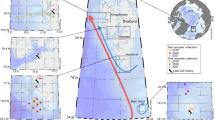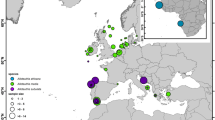Abstract
Two key players in the Arctic and subarctic marine ecosystem are the calanoid copepods, Calanus finmarchicus and C. glacialis. Although morphologically very similar, these sibling species have different life cycles and roles in the Arctic pelagic marine ecosystem. Considering that the distribution of C. glacialis corresponds to Arctic water masses and C. finmarchicus to Atlantic water masses, the species are frequently used as climate indicators. Consequently, correct identification of the two species is essential if we want to understand climate-impacted changes on Calanus-dominated marine ecosystems such as the Arctic. Here, we present a novel morphological character (redness) to distinguish live females of C. glacialis and C. finmarchicus and compare it to morphological (prosome length) and genetic identification. The characters are tested on 300 live females of C. glacialis and C. finmarchicus from Disko Bay, western Greenland. Our analysis confirms that length cannot be used as a stand-alone criterion for separation. The results based on the new morphological character were verified genetically using a single mitochondrial marker (16S) and nuclear loci (six microsatellites and 12 InDels). The pigmentation criterion was also used on individuals (n = 89) from Young Sound fjord, northeast Greenland to determine whether the technique was viable in different geographical locations. Genetic markers based on mitochondrial and nuclear loci were corroborative in their identification of individuals and revealed no hybrids. Molecular identification confirmed that live females of the two species from Greenlandic waters, both East and West, can easily be separated by the red pigmentation of the antenna and somites of C. glacialis in contrast to the pale opaque antenna and somites of C. finmarchicus, confirming that the pigmentation criterion is valid for separation of the two species.




Similar content being viewed by others
References
Arendt KE, Nielsen TG, Rysgaard S, Tönneson K (2010) Differences in plankton community structure along the Godthåbsfjord; from the Greenland Ice Sheet to offshore waters. Mar Ecol Prog Ser 401:49–62
Belkhir K, Borsa P, Goudet J, Chikhi L, Bonhomme F (2001) G E N E T I X, logiciel sous WindowsTM pour la genetique des populations. Laboratoire Genome et populations, Montpellier
Conover RJ (1988) Comparative life histories in the genera Calanus and Neocalanus in high latitudes of the Northern Hemisphere. Hydrobiologia 167:127–142
Coyer JA, Hoarau G, Stam WT, Olsen JL (2007) Hybridization and introgression in a mixed population of the intertidal seaweeds Fucus distichus and F. serratus. J Evol Biol 16:3606–3616
Dünweber M, Swalethorp R, Kjellerup S, Nielsen TG, Møller EF, Hjort M, Arendt K, Tönnesson K (2010) Fate of the spring diatom bloom in Disko Bay, western Greenland. Mar Ecol Prog Ser 419:11–29
Falk-Petersen S, Pavlov V, Timofeev S, Sargent JR (2007) Climate variability and possible effects on arctic food chains: the role of Calanus. Arctic alpine ecosystems and people in a changing environment. Springer, Berlin, pp 147–166
Falk-Petersen S, Mayzaud P, Kattner G, Sargent J (2009) Lipids and life strategy of Arctic Calanus. Mar Biol Res 5:18–39
Frost BW (1974) Calanus marshallae, a new species of calanoid copepod closely allied to sibling species Calanus finmarchicus and Calanus glacialis. Mar Biol 26:77–99
Gabrielsen TM, Merkel B, Søreide JE, Johansson-Karlsson E, Bailey A, Vogedes D, Nygård D, Varpe Ø, Berge J (2012) Potential misidentifications of two climate indicator species of the marine arctic ecosystem: Calanus glacialis and C. finmarchicus. Polar Biol 35:1621–1628
Hansen MO, Nielsen TG, Stedmon C, Munk P (2012) Oceanographic regime shift during 1997 in Disko Bay, Western Greenland. Limnol Oceanogr 57(2):634–644
Hirche H-J, Kattner G (1993) Egg production and lipid content of Calanus glacialis in spring: indication of a food-dependent and food-independent reproductive mode. Mar Biol 117:615–622
Hirche HJ, Kosobokova K (2007) Distribution of Calanus finmarchicus in the northern North Atlantic and Arctic Ocean: expatriation and potential colonization. Deep-Sea Res II 54:2729–2747
Hirche H-J, Hagen W, Mumm N, Richter C (1994) The northeast water Polynya, Greenland Sea. 3. Mesozooplankton and macrozooplankton distribution and production of dominant herbivorous copepods during spring. Polar Biol 14:491–503
Kjellerup S, Dünweber M, Swalethorp R, Nielsen TG, Møller EF, Markaager S, Hansen BW (2012) The effect of a future warmer ocean on the co-existing copepods Calanus finmarchicus and C. glacialis in the Disko bay western Greenland. Mar Ecol Prog Ser 447:87–108
Levinsen H, Nielsen TG, Hansen BW (2000) Annual succession of marine protozoans in the arctic with emphasis on winter dynamics. Mar Ecol Prog Ser 206:119–134
Lindeque PK, Harris RP, Jones MB, Smerdon GR (1999) Simple molecular method to distinguish the identity of Calanus species (Copepoda: Calanoida) at any developmental stage. Mar Biol 133:91–96
Lindeque PK, Harris RP, Jones MB, Smerdon GR (2004) Distribution of Calanus spp. as determined using a genetic identification system. Sci Mar 68(Suppl 1):121–128
Lindeque PK, Hay SJ, Heath MR, Ingvarsdottir A, Rasmussen J, Smerdon GR, Waniek JJ (2006) Integrating conventional microscopy and molecular analysis to analyse the abundance and distribution of four Calanus congeners in the North Atlantic. J Plank Res 27(12):1–18
Madsen SD, Nielsen TG, Hansen BW (2001) Annual population development and production by Calanus finmarchicus and C. glacialis during the Arctic spring. Mar Ecol Prog Ser 353:177–190
Madsen SJ, Nielsen TG, Tervo OM, Söderkvist J (2008) On the importance of feeding for egg production of Calanus finmarchicus and C. glacialis during the Arctic spring. Mar Ecol Prog Ser 353:177–190
Nielsen EE, Bach LA, Kotlicki P (2006) H Y B R I D L A B (version 1.0): a program for generation simulated hybrids from population samples. Mol Ecol Notes 6:971–973
Nielsen TG, Ottosen LD, Hansen BW (2007) Structure and function of the pelagic ecosystem in an ice covered arctic fjord. In: Rysgaard S, Glud RN (eds) Carbon cycling in Arctic marine ecosystems: case study Young Sound. Bioscience Special Issue, Meddr Greenland, pp 88–107
Palumbi SR, Benzie J (1991) Large mitochondrial DNA differences between morphologically similar Penaeid shrimp. Mol Mar Biol Biotech 1:27–34
Parent GJ, Plourde S, Turgeon J (2011) Overlapping size ranges of Calanus spp. off the Canadian Arctic and Atlantic coasts: Impact on species’ abundances. J Plank Res 33:1654–1665
Parent JG, Plourde S, Turgeon J (2012) Natural hybridization between Calanus finmarchicus and C. glacialis (Copepoda) in the Arctic and Northwest Atlantic. Limnol Oceanogr 57(4):1057–1066
Plourde S, Runge JA (1993) Reproduction of the planktonic copepod Calanus finmarchicus in the lower St. Lawrence Estuary: relation to the cycle of phytoplankton production and evidence for a Calanus pump. Mar Ecol Prog Ser 102:217–228
Pritchard J, Stephens M, Donnelly P (2000) Inference of population structure using multilocus genotype data. Genetics 155(2):945–959
Provan J, Beatty GE, Keating SL, Maggs CA, Savage G (2009) High dispersal potential has maintained long-term population stability in the North Atlantic copepod Calanus finmarchicus. Proc R Soc B Biol Sci 276:301–307
Rysgaard S, Nielsen TG, Hansen BW (1999) Seasonal variation in nutrients, pelagic primary production and grazing in a high-Arctic coastal marine ecosystem, Young Sound, Northeast Greenland. Mar Ecol Prog Ser 179:13–25
Slagstad D, Ellingsen IH, Wassmann P (2011) Evaluating primary and secondary production in an Arctic Ocean void of summer sea ice: an experimental simulation approach. Prog Oceanogr 90:117–131
Smolina I, Kollias S, Poortvliet M, Nielsen TG, Lindeque P, Castellani C, Møller EF, Blanco-Bercial L, Hoarau G (2014) Genome- and transcriptome-assisted development of nuclear insertion/deletion markers for Calanus species (Copepoda: Calanoida) identification. Mol Ecol Res. doi:10.1111/1755-0998.12241
Swalethorp R, Kjellerup S, Dünweber M, Nielsen TG, Møller EF, Rysgaard S, Hansen BW (2011) Production of Calanus finmarchicus, C. glacialis and C. hyperboreus in Disko Bay, western Greenland, with emphasis on life strategy. Mar Ecol Prog Ser 429:125–144
Unstad KH, Tande KS (1991) Depth distribution of Calanus finmarchicus and Calanus glacialis in relation to environmental conditions in the Barents Sea. Polar Res 10:409–420
Werner I, Hirche H-J (2001) Observations on Calanus glacialis eggs under the spring ice in the Barents Sea. Polar Biol 24:296–298
Acknowledgements
The research leading to these results has received funding from the European Commission FP7 EURO-BASIN project (Grant Agreement: 264 933), the Greenland Climate Research Centre (Project 6505) and the Norwegian Research Council (Project HAVKYST 216578). We would like to thank Mette D. Agersted for collecting Calanus from the East Greenland. We would like to thank the Arctic Station Qeqertarsuaq, University of Copenhagen that provided an excellent working platform on land as well as the captain and the crew on R. V. Porsild for great technical support at sea. We also thank Katharine Pemberton, Spyros Kollias and Marloes Poortvliet for their assistance with genotyping.
Author information
Authors and Affiliations
Corresponding author
Additional information
Communicated by X. Irigoyen.
Electronic supplementary material
Below is the link to the electronic supplementary material.
Rights and permissions
About this article
Cite this article
Nielsen, T.G., Kjellerup, S., Smolina, I. et al. Live discrimination of Calanus glacialis and C. finmarchicus females: can we trust phenological differences?. Mar Biol 161, 1299–1306 (2014). https://doi.org/10.1007/s00227-014-2419-5
Received:
Accepted:
Published:
Issue Date:
DOI: https://doi.org/10.1007/s00227-014-2419-5




